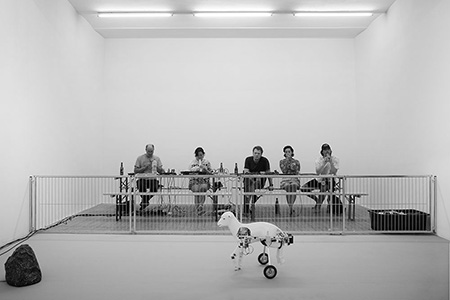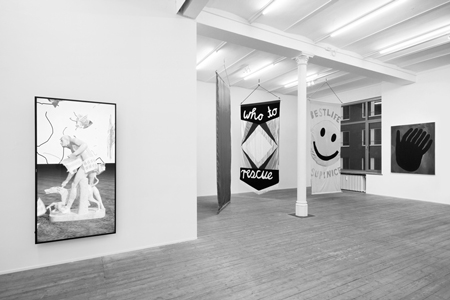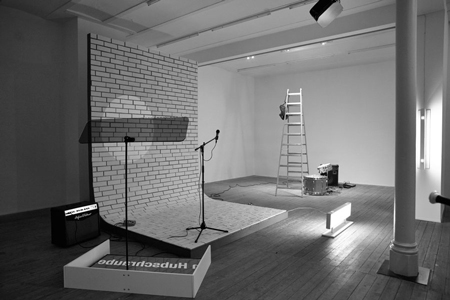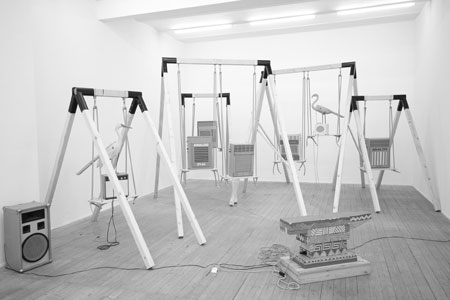
Christina Koehler, the_oaten_flute .mid
1. July - 29. July 2022
exhibition views
Funded by Musikfonds e.V.
(BKM Federal Government Commissioner for Culture and Media)
NEUSTART KULTUR and Hamburgische Kulturstiftung
bucolica .exe (2022)
experimental pastoral opera, sound performance/installation
bucolica.exe, the_oaten_flute.mid and leontopodium_fortuna.wav are three different pastoral opera versions inspired by concepts of the mountainous idyll of the Swiss Alps and one of its most famous inhabitants, the fictitious character “Heidi.” They explore the relationships between ruralism and nationalism, questioning common-held idealizations of a pastoral lifestyle by investigating how it forms identity, and touching upon the recent resurgence of völkisch—ethno-nationalist ideologies in Germany.
By juxtaposing self-built musical instruments—sculptural works that could be described as “sound objects”—with future-oriented technologies such as 3D holograms and a singing goat robot a dystopian setting is created to accommodate an AI supported musical piece based on duets between the robot goat and a hologram girl.

Christina Koehler, Jil Lahr, Christian Rothmaler, Supinice, In his ideal the center of ...
5. April - 4. May 2019
exhibition views
In his ideal the center of the pit was to remain free of any shadow cast by the new buildings
Christian Rothmaler’s painting Get Cream in Neom looks like the outsized likeness of a hand. Casting no discernible shadow, the limb hovers at the center of the picture before a bright nonrepresentational background, a compositional template familiar to art historians from depictions of one of Christianity’s most mysterious relics: the Veil of Veronica. The peculiar sheen of the flesh tones may remind a beholder contemplating the hand of the otherworldly elegance of fourteenth-century frescoes in Italian churches—this hand, however, boasts seven fingers. The work’s title makes reference to the smart city Neom, a futuristic metropolis, running entirely on bioenergy and populated by a new and optimized subspecies of humanity, that is projected to rise in the desert of Saudi Arabia. Might the picture show the greeting of an emerging élite, the gesture with which its deity dispenses its blessing, the promulgation of a superior culture to come?
If the hand appears to float on a screen whose brightness setting is turned up too high, the effect is in part due to the luminous yellowish-white grid background. It is a nod to a technical imaging procedure that is emblematic of the objective and accurate recording, transmission, and production of reality. In the history of art, it has become a theme in its own right—see, for instance, Dürer’s Draftsman Drawing a Reclining Nude, which conveys the artist’s conviction that his work carried the authority of a scientific practice. Today’s users can rely on online tutorials to teach them all they need to know about 3D rendering software and the creation of animated characters and virtual spaces. Avatars can be assembled from individual perfectly shaped body parts; failed species filter back through the virtual biotopes of pluridimensional gaming universes into our realities. A two-dimensional version—a mere outline—of a dinosaur comes into view under the title Guess Who’s Back. Jil Lahr lets the figure sprawl over almost the entire large-format canvas and eschews any suggestion of spatial depth. A sweeping green line activates the picture as a whole. Only upon closer examination do we realize that it is a retroactive simulation of a spontaneous remark: the line is not in fact an improvisation but a formal element that was digitally generated, tested, and only then transferred in halting brushstrokes onto the canvas. The meticulously balanced composition leaves no room for coincidence, expressiveness, or painterly gesture. Like Rothmaler’s hovering hand, the dinosaur does not cast a shadow. All in all, it resembles a pictogram rendered in isolation rather than a physical body convincingly integrated into, and interacting with, its surroundings.
The acknowledgment of such discontinuity implies a candor that unites the contributions to this exhibition. As a consumer and predator, the user operates in a space whose coordinates spanning an expanded reality grow increasingly diverse and complex even as they also become ever more constricted, being constantly adjusted to his behavior. Such personalized versions of reality remain valid only until their popularity fades and they cease to be profitable for users and providers alike. Scenarios of dilapidation and proliferating wastelands are part and parcel of these cultures and conceptions of reality (temple complexes, smart cities, shopping paradises, Second Life). Like a memento mori, animated cheeseburger wrapping papers drift weightlessly through Christina Koehler’s video piece Yellow Dog Blues, the detritus of a long-gone future, grazing the ideally proportioned bodies of an ancient freestanding sculpture spinning forever around its own axis. In the otherwise sparsely outfitted simulation, collective memories of the parchment-like paper with its silky rustle make for a poetic touch, its pop-cultural perfection muting questions concerning originality and authorship as clinging to the insignificant problems of a past era. A Pikachu Pokémon comes into view. Where are we now? In a world we can already hold in hand wherever we go and will soon embed in our retinas?
(The title of the exhibition alludes to the wishes of a famous Land artist who, in 1969, had an enormous hole in the ground excavated in an unused plot of land in Munich for a work he called Munich Depression. His vision was that, as the city would grow over the next several decades, planners would ensure that new buildings and their shadows would keep their distance from the crater. The ideal of a permanent artistic alteration of the world survives in a contemporary black-and-white photograph.)
DE
Die Malerei Get Cream in Neom von Christian Rothmaler wirkt wie das überdimensionale Bildnis einer Hand. Sie schwebt, ohne einen Schatten zu werfen, im Bildzentrum vor einem hellen und ungegenständlichen Hintergrund, wie man es in der Kunstgeschichte von Darstellungen einer der geheimnisvollsten Reliquien des Christentums kennt: des Schweißtuchs der Veronika. Was das seltsame Schimmern des Inkarnats betrifft, könnte man sich beim Betrachten der Hand an die entrückte Eleganz italienischer Kirchenfresken des 14. Jahrhunderts erinnert fühlen – allerdings hat diese Hand sieben Finger. In dem Titel der Arbeit wird auf die Smart City Neom verwiesen, die als vollständig von Bioenergie betriebene Zukunftsstadt für den neuen, optimierten Menschen in der saudiarabischen Wüste entstehen soll. Ist das Bild möglicherweise der Gruß einer neuen Elite, der Segensgestus ihrer Gottheit, die Verkündung einer überlegenen kommenden Kultur?
Dass die Hand wie auf einem zu hell eingestellten Bildschirm zu schweben scheint, ist auch ein Effekt, den der leuchtende gelb-weiße Gittergrund erzeugt. Das Bild verweist damit auf ein technisches Bildverfahren, das für die objektive, genaue Erfassung, Übertragung und Produktion von Wirklichkeit steht und in der Kunstgeschichte als Instrument selbst zum Bildgegenstand wurde – zum Beispiel in Dürers Der Zeichner des liegenden Weibes, der damit sein Selbstverständnis als wissenschaftlich arbeitende Autorität zum Ausdruck brachte. Heute steht Nutzern das Wissen über 3D-Rendering-Software zum Kreieren von Charakteranimationen und virtuellen Räumen in Online-Tutorials zur Verfügung. Avatare lassen sich aus einzelnen ideal geformten Körperteilen zusammensetzen, gescheiterte Spezies finden in den virtuellen Lebensräumen mehrdimensionaler Spielwelten zurück in unsere Wirklichkeiten. In zweidimensionaler Version, als reine Umrisslinie, betritt unter dem Titel Guess Who’s Back ein Dinosaurier das Feld. Jil Lahr räumt der Figur beinahe die ganze Bildfläche der großformatigen Leinwand ein und vermeidet dabei jede Andeutung von Raum. Eine schwungvolle grüne Linie aktiviert das gesamte Bild. Dass sie einen spontanen, nachträglich auf das Bild aufgetragenen Kommentar nachahmt, fällt erst auf den zweiten Blick auf. Tatsächlich ist nämlich die Linie nicht improvisiert, sondern als formales Element digital erstellt, getestet und dann erst in stockendem Duktus auf die Leinwand übertragen worden. In dieser genau austarierten Komposition ist kein Raum für Zufall, Expressivität oder Gestus. Wie die schwebende Hand bei Rothmaler wirft auch der Dinosaurier keine Schatten. Er kommt damit einem freigestellten Piktogramm näher als einem schlüssig in sein räumliches Umfeld eingebetteten, interagierenden Körper.
Im Anerkennen dieser Diskontinuität liegt eine Aufrichtigkeit, die den Beiträgen dieser Ausstellung gemeinsam ist. Als Konsument und Jäger agiert der Nutzer in einem Raum, dessen Koordinaten als erweiterte Realität zunehmend vielfältiger und komplexer werden, während sie sich gleichzeitig immer weiter verengen, weil sie nach seinem Verhalten ausgerichtet sind. Diese personalisierten Versionen von Wirklichkeit behalten nur so lange ihre Gültigkeit, bis ihre Popularität schwindet und sie sich für Nutzer und Anbieter nicht mehr rentieren. Verfallsszenarien und sich ausbreitende Einöden sind den Kulturen und Wirklichkeitskonzepten immer mit eingeschrieben (Tempelanlagen, Smart Cities, Einkaufsparadiese, Second Life). Wie ein Memento Mori schweben in der Videoarbeit Yellow Dog Blues von Christina Koehler animierte Cheeseburger-Papiere schwerelos aus einer längst vergangenen Zukunft vorüber und streifen dabei die ideal geformten Körper einer für immer um sich selbst rotierenden antiken Freiplastik. In der ansonsten spärlich ausgestatteten Simulation entfalten kollektive Erinnerungen an das pergamentartige und seidig knisternde Einwickelpapier eine Poesie, die in ihrer popkulturellen Vollkommenheit Fragen nach Original und Urheberschaft als unwesentliche Probleme einer vergangenen Epoche verhallen lässt. Ein Pikachu-Pokémon taucht auf. Wo sind wir jetzt? In einer Welt, die man schon jetzt in einer Hand und bald auf der Netzhaut mit sich herumtragen kann?
(Der Titel der Ausstellung bezieht sich auf die Forderung eines berühmten Vertreters der Land Art, der 1969 einen enormen Krater in einer städtischen Brache in München ausheben ließ und die Arbeit mit Munich Depression betitelte. Seiner Vorstellung nach wäre die sich ausdehnende Stadt in den darauffolgenden Jahrzehnten so geplant worden, dass Neubauten und deren Schatten ausreichend Abstand zu dem Krater gewahrt hätten. Dieses Ideal einer dauerhaften künstlerischen Setzung hat sich in einer zeitgenössischen Schwarzweißfotografie konserviert.)

Christina Köhler, Reign of Error
2. June - 1. July 2017
exhibition views
Reign of Error, the environment Christina Koehler has set up at Galerie Conradi, consists of three different arrangements that function as fragmentary stage settings of sorts. In the course of the performance, the artist will activate one after the other: It begins with the physically demanding attempt to elicit a few piteous notes from a bagpipe she has fashioned out of an ALDI plastic bag. The improvised instrument is connected to a recording device and amplifier, which take live samples of the sound that are replayed as the artist moves on the next station.
Balancing on a tall ladder, she then flings various tennis balls, energy drinks, and beer cans from an IKEA bag, striking drums set on the floor with now surer, now less sure aim. Again, the resulting noise is recorded, sampled, and mixed with the notes from the first part of the performance. This second action pays homage to the Fluxus artist George Brecht, whose performance Drip Music—the dramaturgy involved a curtain and stage—similarly employed a ladder and a receptacle placed beneath it to produce sounds.
The third and final station quotes the fairytale The Wizard of Oz—the rudimentary television studio set with the yellow foam-rubber fake bricks distinctly recalls the yellow brick road leading to the Emerald City. Standing on it, the artist now takes on the challenge of a teleprompter made dysfunctional by severe deceleration. Slipping into the role of stand-up comedienne, she reads off stale gags, but the low speed setting of the scrolling text and the grotesque electronic distortion of her voice resounding from the speakers make it impossible to make any sense of the scene. The abstract verbal fragments she speaks into the microphone and the sounds and noises from the previous stations condense into a collage-like composition. The performance yields an improvised and complex electronic soundscape, an ephemeral construct that, over the course of the performance, feels increasingly unconnected to the artist’s actions. The audience—utterly absorbed in her various roles and situations, the artist never makes direct contact with the spectators—is accosted by two illuminated advertisements, so-called Audience Pieces, that display stage directions such as emoticons signaling laughter and clapping hands.
Christina Koehler works with pop-cultural references as well as material she appropriates from the art field. Her work features numerous elements that derive from Fluxus and Dada. In her system, self-reference clashes with comedy in happenings that negotiate the artist’s role: as a comedienne without a punch line, a failing musician, a Fluxus artist who gets her props at the discount store. An ongoing shift of perspectives charts possible purposes and uses of the gallery space: resonance chamber, studio, stage, scenery.
In addition to her exhibitions and performances as a solo artist, Christina Koehler collaborates with various international artists’ initiatives and performance art networks. She is a founder and member of the Musicmotorcycle Club and the Krachkisten-Orchester, with which she has toured Europe for many years.
DE
Christina Koehler hat unter dem Titel Reign of Error in der Galerie Conradi ein Environment aus drei verschiedenen Anordnungen geschaffen, die wie einzelne Bühnenfragmente funktionieren und die während der Performance durch die Künstlerin nacheinander aktiviert werden: Den Anfang bildet der unter körperlicher Anstrengung unternommene Versuch, aus einem selbst gebastelten ALDI-Tüte-Dudelsack ein paar klägliche Töne hervorzubringen. Das improvisierte Instrument ist an Aufnahmegerät und Verstärker angeschlossen, so wird der Sound live gesampelt und bleibt hörbar, während die Künstlerin zur nächsten Station wechselt.
Auf einer hohen Leiter balancierend schleudert sie nun mal mehr mal weniger zielsicher verschiedene Tennisbälle, Energy-Drinks und Bierdosen aus einer IKEA-Tasche herunter auf Schlagzeugtrommeln. Die Geräusche, die dabei entstehen, werden wieder aufgezeichnet und gesampelt und vermischen sich nun mit den Tönen aus dem ersten Teil der Performance. Bei dieser zweiten Aktion handelt es sich um eine Reverenz an den Fluxus-Künstler George Brecht, dessen mit Vorhang und Bühne dramaturgisch inszenierte Drip Music-Performance auf ähnliche Weise zur Erzeugung von Geräuschen eine Leiter und ein darunter positioniertes Gefäß zum Einsatz brachte.
Die dritte und letzte Station zitiert das Märchen Der Zauberer von Oz –die angedeutete Fernseh-Kulisse erinnert mit ihren Ziegelsteinattrappen aus gelbem Schaumstoff stark an die zur Smaragd-Stadt führende Yellow Brick Road. Auf dieser versucht sich die Künstlerin nun an einem dysfunktionalen, da stark verlangsamten Teleprompter. In der Rolle des Stand-up-Comedians liest sie flache Witze ab, die niedrige Geschwindigkeit des Lauftextes aber und die groteske elektronische Verzerrung ihrer Stimme, die aus dem Lautsprecher hallt, machen den Auftritt vollkommen unverständlich. Die abstrakten Sprachfragmente, die ins Mikrophon eingesprochen werden, verdichten sich mit den bereits produzierten Tönen und Klängen zu einer collageartigen Komposition. Ergebnis der Aktion ist ein improvisierter und komplexer Elektrosound, ein flüchtiges Gebilde, das sich im Verlauf der Performance zunehmend von der Handlung der Künstlerin abzulösen scheint. An das Publikum, zu dem die mit ihren verschiedenen Rollen und Situationen vollends beschäftigte Künstlerin keinen direkten Kontakt aufbaut, richten sich zwei Leuchtreklamen, sogenannte Audience Pieces, auf denen Regieanweisungen wie lachende Emoticons und klatschende Hände zu erkennen sind.
Christina Koehler arbeitet mit popkulturellen Bezügen sowie Aneignungen aus dem Feld der Kunst. In ihrer Arbeit finden sich zahlreiche Elemente von Fluxus und Dada. Selbstreferentialität trifft in ihrem System auf Komik, wenn die Rolle der Künstlerin ereignishaft verhandelt wird: als Comedian ohne Pointe, als scheiternde Musikerin, als Fluxuskünstlerin mit Requisiten vom Discounter. Es kommt zu Verschiebungen der Perspektiven und in Bezug auf die Bestimmung des Galerieraumes, seine Nutzung: Der Raum wird Klangraum, Studio, Bühne, Kulisse.
Neben ihren Ausstellungen und Auftritten als Solo-Künstlerin kooperiert Tintin Patrone mit unterschiedlichen internationalen Künstlerinitiativen und Performancekunst-Netzwerken. Sie ist Gründerin und Mitglied des Musicmotorcycle Club und des Krachkisten-Orchesters, mit dem sie seit vielen Jahren durch Europa tourt.

Christina Köhler, My ABC's
13. June - 26. July 2014
exhibition views
Christina Koehler describes herself as a performance artist, instrument maker and—using a label she has adopted from the experimental musician and performance artist Frieder Butzmann (b. 1954)—‘noisemakista.’ Her performances and installations include elements from punk rock, Fluxus, and Futurism. Another important inspiration that informs her artistic practice is the culture of associations and clubs; she often performs with her orchestra or cooperates with other artists and collectives. For her first solo show at Conradi, the artist has designed a site-specific work in space. The opening will be celebrated with a performance of her Krachkisten Orchester in the gallery.
The Krachkisten Orchester produces improvised electric sounds. In addition to gigs at Hamburg’s Golem and Golden Pudel clubs, the orchestra, which was founded in 2009, has toured Germany and Europe. In the past several years, various artists’ initiatives such as the French performance art network dimanche rouge and the Belgian project for performative art sign 6 invited the Krachkisten Orchester to Paris, Brussels, and Helsinki; machine raum, a Danish platform for video art and digital culture, brought the ensemble to the Vejle Kunstmuseum.
Inspired by the intonarumori (noise-intoners) the Italian Futurist Luigi Russolo (b. 1883) invented, the Krachkisten or noise boxes used in the orchestra’s concerts are homemade analogue instruments enhanced with electronic components taken from dismantled children’s toys. The presentation in an exhibition space highlights the modernist-looking design of the boxes, lending them a sculptural appeal that complements their functionality. This sort of interplay between music, art, sound, and experimental gestures is what Tintin Patrone is interested in.
With its monumental aura and visual allure, the multipart picture that takes up the entire row of windows in the gallery creates the impression that one is standing in a cathedral or before an altar. At the center of the loudly colorful triptych, Big Bird sits on his throne in the guise of a double-headed hybrid eagle, flanked by Dave Gahan, who has fallen to his knees in reverence, and other legendary creatures, Aztec deities, and assorted minor beasts that populate this stylized world out of time and space—all of them icons from typefaces that are available for free online. Letters turn into little birds, text becomes image, the popular code for an iconographic program that aims at rapid persuasion and the ritual annunciation of ebullience, everywhere and in radiant colors and as secular as possible! Like the artist’s work in the performative register, this visual production implements the processes of appropriation on which it is based with a self-reflective gesture. But where the Krachkisten Orchestra and projects like the Musicmotorcycle Club stand for social interaction, what the artist composes in her monumental picture, though no less loud, is also desolate distortion by overmodulation of image, culture, and history: a winged altarpiece for the new positive society.
DE
Christina Koehler bezeichnet sich als Performancekünstlerin, Instrumentenbauerin und – in Anlehnung an den Experimentalmusiker und Performancekünstler Frieder Butzmann (*1954) – als ‚Krachmacheur‘. In ihren Performances und Installationen finden sich Elemente von Punkrock, Fluxus und Futurismus. Ein wichtiger Punkt, der auch ihre künstlerische Praxis bestimmt, ist die Vereins- und Clubkultur, weshalb sie häufig mit ihrem Orchester oder in Kooperation mit anderen Künstlern und Kollektiven in Erscheinung tritt. Für ihre erste Einzelausstellung bei Conradi hat die Künstlerin eine raumspezifische Arbeit entworfen und wird am Eröffnungsabend zusammen mit dem Krachkisten Orchester in der Galerie auftreten.
Das Krachkisten Orchester produziert improvisierten Elektrosound, neben Auftritten im Golem und im Golden Pudel Club in Hamburg tourt es seit seiner Gründung 2009 durch Deutschland und Europa und wurde in den letzten Jahren von unterschiedlichen Künstlerinitiativen wie dem französischen Performancekunst-Netzwerk dimanche rouge und dem belgischen Projekt für performative Kunst sign6 nach Paris, Brüssel und Helsinki sowie von machine raum, einer dänischen Plattform für Videokunst und digitale Kultur, in das Vejle Kunstmuseum eingeladen.
Die für die Konzerte eingesetzten Krachkisten sind mit der Elektronik von auseinandergebautem Kinderspielzeug ausgestattete selbst konstruierte analoge Instrumente, inspiriert von den intonarumori
(dt. Geräuschtöner) des italienischen Futuristen Luigi Russolo (*1883). Die Präsentation in einem Ausstellungsraum und ihre modernistisch anmutende Gestaltung verleiht den Kisten neben der funktionalen auch eine skulpturale Qualität. Es sind diese Zusammenhänge zwischen Musik, Kunst, Sound und experimenteller Geste, für die sich Tintin Patrone interessiert.
Das mehrteilige Bild, das die gesamte Fensterreihe der Galerie einnimmt, erzeugt in seiner Monumentalität und visuellen Anziehungskraft eine kathedralenartige oder altarhafte Wirkung: Im Zentrum dieses knallfarbenen Triptychons thront Bibo als
Doppeladler-Hybrid, flankiert von einem in Anbetungsgeste verharrenden Dave Gahan und anderen Fabelwesen, aztekischen Gottheiten und kleineren Kreaturen, die diese stilisierte zeit– und raumlose Welt bevölkern – sie alle sind Icons aus kostenlosen Online-Schriftarten. Buchstaben werden zu Vögelchen, aus Text wird Bild, der populäre Code für ein Bildprogramm, das auf schnelle Überzeugung setzt, auf die sakrale Verkündung überall und farbenfroh und zwar möglichst profan erstrahlender Bestlaune! Wie im Performativen äußert sich auch in der hier praktizierten Bildproduktion in Bezug auf die Prozesse der Aneignung eine selbstreflexive Geste. Während allerdings das Krachkisten Orchester oder Projekte wie der Musicmotorcycle Club für gesellschaftliche Interaktion stehen, komponiert die Künstlerin in dem Monumentalbild eine ebenso laute aber auch desolate Übersteuerung von Bild, Kultur und Geschichte: einen Flügelaltar für die neue Positivgesellschaft.